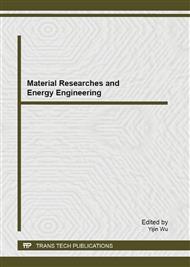[1]
R. Raghavan, J.D.T. Scorer, F.G. Miller. An investigation by numerical methods of the effect of pressure-dependent rock and fluid properties on well flow tests., Old SPE Journal 12, no. 3 (1972): 267-275.
DOI: 10.2118/2617-pa
Google Scholar
[2]
V.F. Samaniego, W.E. Brigham, F.G. Miller. An investigation of transient flow of reservoir fluids considering pressure-dependent rock and fluid properties., Old SPE Journal 17, no. 2 (1977): 141-150.
DOI: 10.2118/5593-pa
Google Scholar
[3]
J. Vairogs, C.L. Hearn, D.W. Dareing, et al. Effect of rock stress on gas production from low-permeability reservoirs., Journal of Petroleum Technology 23, no. 9 (1971): 1161-1167.
DOI: 10.2118/3001-pa
Google Scholar
[4]
J. Vairogs, V.W. Rhoades. Pressure transient tests in formations having stress-sensitive permeability., Journal of Petroleum Technology 25, no. 8 (1973): 965-970.
DOI: 10.2118/4050-pa
Google Scholar
[5]
J.F. Evers, E. Soeiinah. Transient tests and long-range performance predictions in stress-sensitive gas reservoirs., Journal of Petroleum Technology 29, no. 8 (1977): 1025-1030.
DOI: 10.2118/5423-pa
Google Scholar
[6]
R.W. Ostensen. The effect of stress-dependent permeability on gas production and well testing., SPE Formation Evaluation 1, no. 3 (1986): 227-235.
DOI: 10.2118/11220-pa
Google Scholar
[7]
O.A. Petrosa. Pressure transient response in stress-sensitive formation., In Paper SPE15115, presented at the 1986 SPE California regional meeting. Oakland, April, pp.2-4. (1986).
DOI: 10.2118/15115-ms
Google Scholar
[8]
J. Kikani, O.A. Pedrosa. Perturbation analysis of stress-sensitive reservoirs., SPE Formation Evaluation 6, no. 3 (1991): 379-386.
DOI: 10.2118/20053-pa
Google Scholar
[9]
S. Berumen, D. Tiab. Interpretation of stress damage on fracture conductivity., Journal of Petroleum Science and Engineering 17, no. 1 (1997): 71-85.
DOI: 10.1016/s0920-4105(96)00057-5
Google Scholar
[10]
L.Y. Chin, R. Raghavan, and L.K. Thomas. Fully coupled geomechanics and fluid-flow analysis of wells with stress-dependent permeability., SPE Journal 5, no. 1 (2000): 32-45.
DOI: 10.2118/58968-pa
Google Scholar
[11]
L.Y. Chin, R. Raghavan, and L.K. Thomas. Fully coupled analysis of well responses in stress-sensitive reservoirs., SPE Reservoir Evaluation & Engineering 3, no. 5 (2000): 435-443.
DOI: 10.2118/66222-pa
Google Scholar
[12]
Q.F. Tao. A numerical model of fracture permeability change in naturally fractured reservoirs using a fully coupled displacement discontinuity method., PhD dissertation, Texas A&M University, May, (2010).
DOI: 10.2118/124745-ms
Google Scholar
[13]
M.J. Fetkovich. Decline curve analysis using type curves., Journal of Petroleum Technology 32, no. 6 (1980): 1065-1077.
DOI: 10.2118/4629-pa
Google Scholar
[14]
T.L. Mccray. Reservoir analysis using production decline data and adjusted time., MS thesis, Texas A&M University, December, (1990).
Google Scholar
[15]
R. Al-Hussainy, H.J. Ramey, and P.B. Crawford. The flow of real gases through porous media., journal of Petroleum Technology 18, no. 5 (1966): 624-636.
DOI: 10.2118/1243-a-pa
Google Scholar
[16]
R. Agarwal. A new method to account for producing time effects when drawdown type curves are used to analyze pressure buildup and other test data., In SPE Annual Technical Conference and Exhibition. (1980).
DOI: 10.2118/9289-ms
Google Scholar
[17]
N. Rahman , L. Kok, and K.A.R.E.L. Zaoral. A new method for computing pseudo-time for real gas flow using the material balance equation., Journal of Canadian Petroleum Technology 45, no. 10 (2006): 36-44.
DOI: 10.2118/06-10-03
Google Scholar
[18]
A.F. Van Everdingen, and H. William. The application of the Laplace transformation to flow problems in reservoirs., Journal of Petroleum Technology 1, no. 12 (1949): 305-324.
DOI: 10.2118/949305-g
Google Scholar


